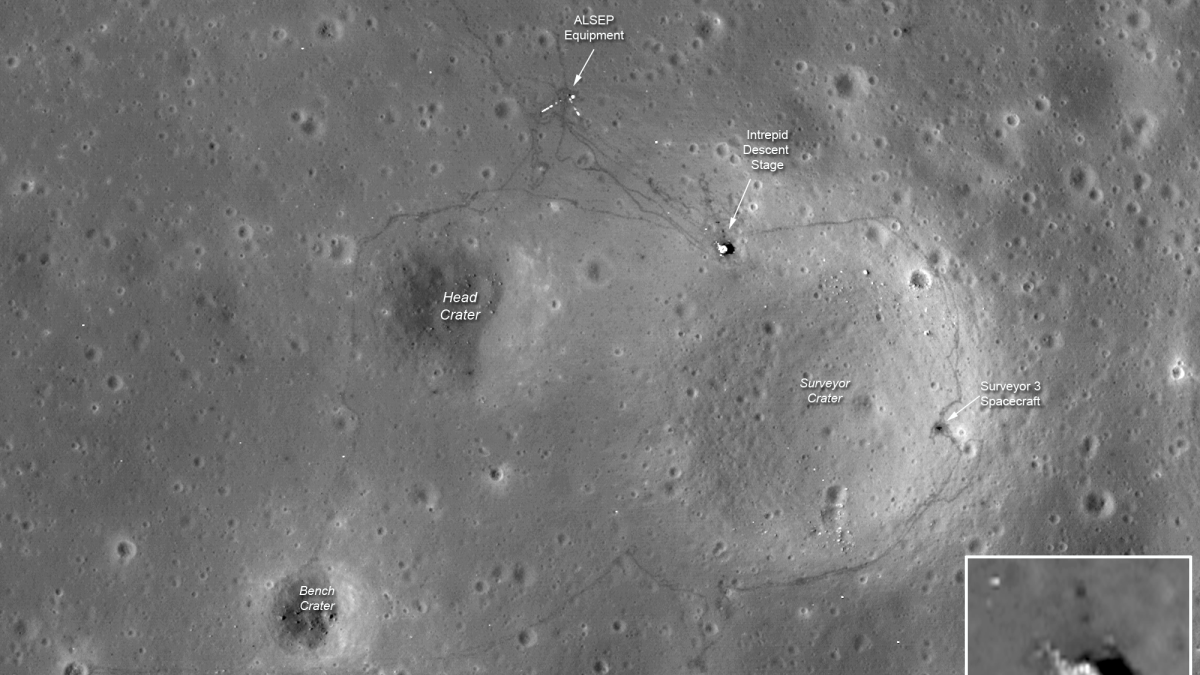New LROC images offer sharper views of Apollo 12, 14, 17 sites

Lower altitude orbit produces images with two times higher resolution
The Arizona State University team that oversees the imaging system on board NASA’s Lunar Reconnaissance Orbiter has released the sharpest images ever taken from space of the Apollo 12, 14 and 17 sites, more clearly showing the paths made when the astronauts explored these areas.
The higher resolution of these images is possible because of adjustments made to LRO’s elliptical orbit. On Aug. 10 a special pair of stationkeeping maneuvers were performed in place of the standard maneuvers, lowering LRO from its usual altitude of 50 kilometers (about 31 miles) to an altitude that dipped as low as 21 kilometers (nearly 13 miles) as it passed over the Moon’s surface.
“The new low-altitude Narrow Angle Camera images sharpen our view of the Moon’s surface,” says Mark Robinson, the principal investigator for LROC and professor in the School of Earth and Space Exploration in ASU’s College of Liberal Arts and Sciences. The LROC imaging system consists of two Narrow Angle Cameras (NACs) to provide high-resolution images, and a Wide Angle Camera (WAC) to provide 100-meter resolution images in seven color bands over a 57-km swath.
“A great example is the sharpness of the rover tracks at the Apollo 17 site,” Robinson said. “In previous images the rover tracks were visible, but now they are sharp parallel lines on the surface!”
The maneuvers were carefully designed so that the lowest altitudes occurred over some of the Apollo landing sites.
At the Apollo 17 site, the tracks laid down by the lunar rover are clearly visible, along with distinct trails left in the Moon’s thin soil when the astronauts exited the lunar modules and explored on foot. In the Apollo 17 image, the foot trails – including the last path made on the Moon by humans – are more easily distinguished from the dual tracks left by the lunar rover, which remains parked east of the lander.
At each site, trails also run to the west of the landers, where the astronauts placed the Apollo Lunar Surface Experiments Package (ALSEP), providing the first insights into the Moon’s internal structure and first measurements of its surface pressure and the composition of its atmosphere.
One of the details that shows up is a bright L-shape in the Apollo 12 image marking the locations of cables running from ALSEP’s central station to two of its instruments. Though the cables are much too small to be resolved, they show up because the material they are made from reflects light very well and thus stand out against the dark lunar soil.
The spacecraft has remained in this orbit for 28 days, long enough for the Moon to completely rotate underneath, thus also allowing full coverage of the surface by LROC’s Wide Angle Camera. This low-orbit cycle ends today when the spacecraft will be returned to the 50-kilometer orbit.
These and other LROC images are available at: http://lroc.sese.asu.edu/